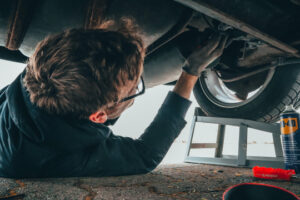Owning a vehicle comes with the responsibility of regular maintenance and occasional repairs. Understanding what constitutes a normal amount of car repairs is crucial for both budgeting and knowing when it’s time to invest in a new ride. While every car’s needs are unique, depending on the owner’s driving habits and use, there are several general guidelines that can help you gauge what’s normal in the world of car upkeep.
Routine Maintenance Items
 Routine maintenance is essential to help optimize the lifespan and overall performance of your vehicle. These are services recommended by the manufacturer at certain intervals to keep your car in optimal condition.
Routine maintenance is essential to help optimize the lifespan and overall performance of your vehicle. These are services recommended by the manufacturer at certain intervals to keep your car in optimal condition.
Common examples of routine maintenance services include:
- Oil Changes: Regular oil changes are essential for engine health. Depending on how much you drive, the mileage of your vehicle, the type of car you own, and the type of oil used, this may be required every 3,000 to 7,500 miles.
- Tire Rotations and Balance: Rotating your tires promotes even wear, extending their lifespan and helping ensure they provide optimal traction. Aim for tire rotations every 5,000 miles or as recommended by your manufacturer.
- Brake Inspections: Regular brake inspections are typically done every six months to help determine how quickly they are wearing down and replace them if necessary.
Other regular maintenance items include changing fluids such as transmission, brake, and coolant, changing spark plugs, inspecting and replacing shocks and struts, replacing batteries, and more.
Repairs Due to Regular Wear and Tear
 As your car ages, certain components will naturally wear out. These repairs are part of the expected maintenance cycle, but their frequency is influenced by a few factors.
As your car ages, certain components will naturally wear out. These repairs are part of the expected maintenance cycle, but their frequency is influenced by a few factors.
Driving habits such as frequent short trips, aggressive driving, and stop-and-go traffic may contribute to more frequent repairs.
The age of your vehicle can also impact how many times you need to visit your mechanic. Older vehicles typically need more upkeep due to the accumulated wear and tear over time.
Where you live also makes a difference in how quickly components need to be replaced. Rough terrain, extreme climates, and living near salt water can all take a toll on your vehicle.
Common ‘wear and tear’ maintenance items include:
- Brake Pad Replacement: Brake pads wear down over time and are typically replaced every 25,000 to 65,000 miles, depending on your driving habits.
- Battery Replacement: Car batteries generally last 3 to 5 years, but extreme temperatures and how often you drive can impact their lifespan.
- Tire Replacements: The overall lifespan of tires varies, but you can expect to replace them every 40,000 to 60,000 miles, depending on your driving habits, road conditions, and the quality of your tires.
- Spark Plug Replacement: Spark plugs can last between 30,000 to 100,000 miles, depending on the type of plugs you have, the fuel you use, and your driving habits.
Unexpected Repairs
In addition to routine wear and tear repairs, unexpected repairs are an unavoidable part of car ownership. Despite your best efforts, things break – often when you least expect it. Additionally, your car is subject to unpredictable damage from the road itself, such as stray rocks, nails, and potholes.
Vehicles that have spent time near salt water are particularly susceptible to surprise problems, as salt from the ocean can corrode parts that are out of sight.
Leaking fluids, damage to the exhaust system, electrical system problems, and cosmetic issues such as dings, scratches, and cracked windshields are just a few of the unexpected repairs a car owner might need to deal with.
High-Mileage Considerations
As your vehicle passes the 100,000-mile mark, it is now considered ‘high mileage’ and may require extra attention.
Common high-mileage services include:
- Timing Belt Replacement: Timing belts typically need replacement every 60,000 to 100,000 miles, depending on the manufacturer’s recommendations.
- Transmission Service: Around the 100,000-mile mark, consider a transmission fluid change and inspection to ensure that your transmission is in good shape. If it’s starting to slip, an inspection can also help you know if it’s time to start budgeting for a new transmission.
- Coolant System Overhaul: Radiators and water pumps may need attention after 100,000 miles to prevent overheating issues.
- Change Your Vehicle’s Oil: Once your vehicle has passed 100,000 miles, you may also want to switch to high-mileage oil. This oil is designed to minimize the chance of leaks, helps clean engine sludge and deposits, and reduces friction between components in your engine.
- Change Your Brake Fluids: Your brake system will likely be flushed around the 60,000 mile mark. Talk to your mechanic about whether your high-mileage car needs brake service at the 100,000 mile mark.
Getting your car routinely serviced over the years can help minimize significant costs in the long run and keep it performing at its best for as long as you own it.
Routine Repairs and More at T3 Atlanta
Understanding what is a normal amount of car repairs for your vehicle involves considering routine maintenance, regular wear and tear, and occasional unexpected issues.
Regular maintenance is essential to maximizing your vehicle’s performance, extending its lifespan, and avoiding major repairs. Whether you’re in need of a regular check-up or more intensive service, give T3 Atlanta a call to make an appointment. We’re ready to help keep your car in top shape for years to come!










Leave a Reply
You must be logged in to post a comment.